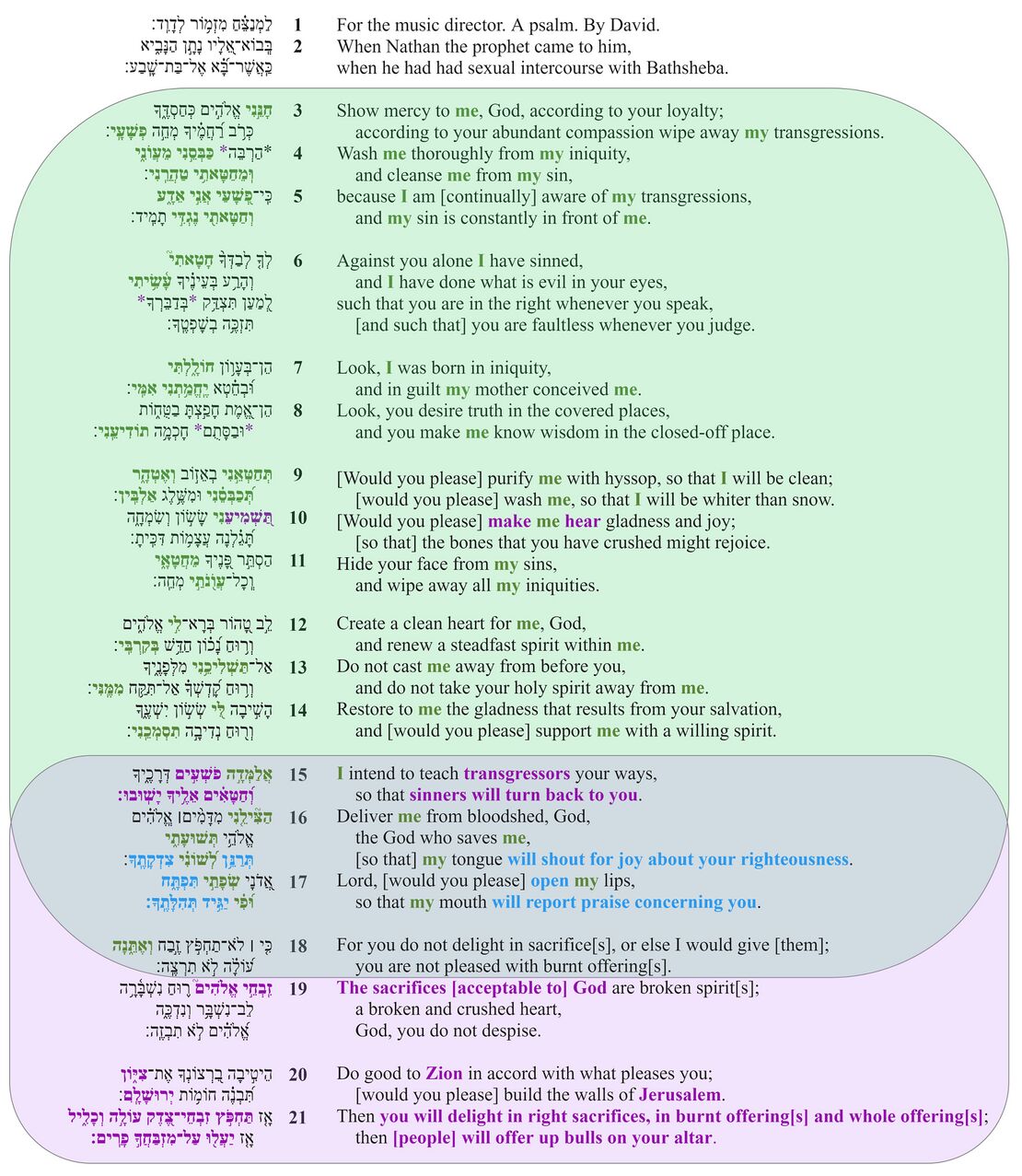Psalm 51 Poetry
About the Poetics Layer
Exploring the Psalms as poetry is crucial for understanding and experiencing the psalms and thus for faithfully translating them into another language. This layer is comprised of two main parts: Poetic Structure and Poetic Features.
Poetic Structure
In poetic structure, we analyse the structure of the psalm beginning at the most basic level of the structure: the line (also known as the “colon” or “hemistich”). Then, based on the perception of patterned similarities (and on the assumption that the whole psalm is structured hierarchically), we argue for the grouping of lines into verses, verses into strophes, strophes into stanzas, etc. Because patterned similarities might be of various kinds (syntactic, semantic, pragmatic, sonic) the analysis of poetic structure draws on all of the previous layers (especially the Discourse layer).
Poetic Features
Bibliography
- Buth, Randall. 1992. "Topic and Focus in Hebrew Poetry—Psalm 51." Pages 83–96 in Hwang Shin Ja J. and William Ro, Merrifield (eds.), Language in Contest: Essays for Robert E. Longacre. Arlington: SIL and the University of Texas.
- Dalglish, Edward R. 1962. Psalm Fifty-One in the Light of Ancient Near Eastern Patternism. Leiden: Brill.
- Eder, Sigrid. 2016. "'Broken Hearted' and 'Crushed in Spirit': Metaphors and Emotions in Psalm 34,19." Scandinavian Journal of the Old Testament 30, no. 1: 1-15.
- Fokkelman, J. P. 2000. Major Poems of the Hebrew Bible at the Interface of Prosody and Structural Analysis, Volume II: 85 Psalms and Job 4-14. Assen: Van Gorcum.
- Goldingay, John. 1978. "Psalm 51:16a (English 51:14a)." CBQ 40, no. 3: 388–90.
- Gunkel, Hermann. 1926. Die Psalmen. HKAT. Göttingen: Vandenhoeck & Ruprecht.
- Kim, Young Bok. 2022. "Hebrew Forms of Address: A Sociolinguistic Analysis. " (Ph.D. diss., University of Chicago).
- Klein, Ernest. 1987. A Comprehensive Etymological Dictionary of the Hebrew Language for Readers of English. Jerusalem: Carta.
- Kraus, Hans-Joachim. 1988. Psalms 1-59. Translated by Hilton C. Oswald. CC.
Minneapolis: Fortress.
- Locatell, Christian S. 2017. "Grammatical Polysemy in the Hebrew Bible: A Cognitive Linguistic Approach to כי." (Ph.D. diss., University of Stellenbosch).
- Lunn, Nicholas P. 2006. "Word-Order Variation in Biblical Hebrew Poetry: Differentiating Pragmatics and Poetics." Paternoster Biblical Monographs. Milton Keynes: Paternoster.
- Magne, Jean. 1958. "Répétition de mots et exégèse dans quelques Psaumes et le Pater." Biblica 39: 177–97.
- Miller, Cynthia L. 2010. "Vocative Syntax in Biblical Hebrew Prose and Poetry: A Preliminary Analysis." Semitic Studies 55, no. 1: 347-364.
- Mowinckel, Sigmund. 1930. "טחות und שֹכוי. Eine Studie zur Astrologie des Alten Testaments." Acta Orientalia 8: 1–44.
- Ross, William A. 2019. "David's Spiritual Walls and Conceptual Blending in Psalm 51." JSOT 43, no. 4: 607-626.
- Shepherd, David J. 2023. King David, Innocent Blood, and Bloodguilt (Oxford: OUP).
- Van der Lugt, Pieter. 2010. Cantos and Strophes in Biblical Hebrew Poetry II: Psalms 42-89. OtSt 57. Leiden: Brill.






